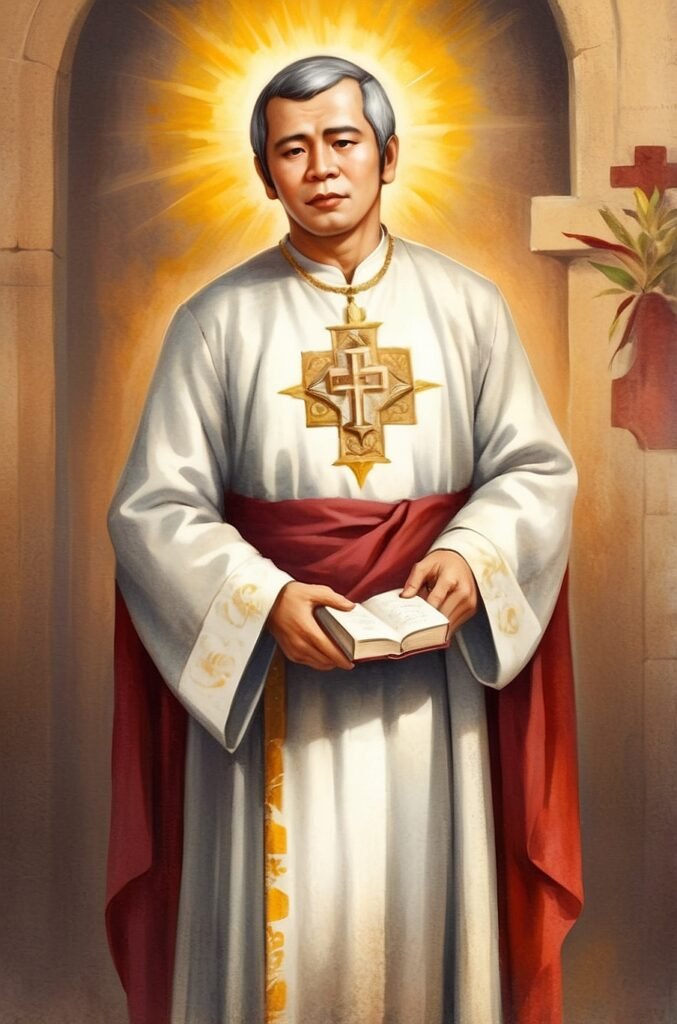Pedro Calungsod, a young Filipino catechist and missionary, holds a significant place in the annals of Philippine history and Catholic faith. Born in the mid-17th century in the Visayas region of the Philippines, Calungsod’s life was marked by unwavering devotion and ultimately, martyrdom. His journey from a humble background to sainthood is a testament to his faith, courage, and commitment to spreading the Gospel. This blog post delves into the life, mission, martyrdom, and canonization of Pedro Calungsod, exploring his impact on Philippine Catholicism and his enduring legacy as the second Filipino saint.
Early Life and Background
Birth and Origins
Pedro Calungsod was born around 1654 in the Visayas region of the Philippines. The exact location of his birth remains a subject of debate among historians, with several places claiming to be his birthplace. These include Ginatilan in Cebu, Loboc in Bohol, and Molo district in Iloilo City. Despite the uncertainty surrounding his precise birthplace, it is widely accepted that Calungsod was of Visayan ethnicity.
Childhood and Education
Little is known about Calungsod’s early life and formal education. However, historical records suggest that he received basic education from the Jesuit missionaries who were active in the Visayas during that period. It is believed that Calungsod learned catechism, reading, writing, and Spanish from these missionaries. His proficiency in the Spanish language and his deep understanding of Catholic doctrine indicate that he was a diligent student and a quick learner.
Religious Formation
Calungsod’s religious formation began at a young age under the guidance of the Jesuit missionaries. He showed an early inclination towards spiritual matters and demonstrated a deep commitment to his faith. This dedication caught the attention of the Jesuits, who recognized his potential as a catechist and missionary helper. As a result, Calungsod was selected to join the missionary expedition to the Marianas Islands, a decision that would ultimately shape his destiny and lead to his martyrdom.
The Marianas Mission
Background of the Mission
The Marianas Mission was a significant undertaking by the Society of Jesus to spread Christianity in the Mariana Islands, then known as the Ladrones Islands. This archipelago in the western Pacific Ocean was largely unexplored by Europeans at the time. The mission was initiated in 1668 under the leadership of Spanish Jesuit priest Diego Luis de San Vitores, who sought to bring Christianity to the Chamorro people, the indigenous inhabitants of the islands.
Calungsod’s Role
Pedro Calungsod, at the young age of about 14, joined the mission as a catechist and assistant to the priests. His primary responsibilities included:
- Teaching catechism to the natives
- Assisting in the celebration of sacraments
- Serving as an interpreter between the missionaries and the Chamorros
- Helping with the daily tasks of the mission
Despite his youth, Calungsod proved to be an invaluable asset to the mission, demonstrating both skill and dedication in his work.
Challenges Faced
The Marianas Mission faced numerous challenges, which Calungsod and his fellow missionaries had to contend with:
- Cultural differences
- Language barriers
- Hostility from some local leaders
- Harsh living conditions
- Limited resources
Despite these obstacles, Calungsod remained committed to the mission, displaying remarkable courage and faith in the face of adversity.
Martyrdom
Events Leading to Martyrdom
The circumstances that led to Pedro Calungsod’s martyrdom were rooted in the complex cultural and political dynamics of the Marianas Islands in the 17th century. Several factors contributed to the growing tension between the missionaries and some of the local population:
- Resistance to cultural change
- Political rivalries among local chiefs
- Misunderstandings about Christian teachings
- Resentment towards Spanish colonial influence
These tensions culminated in a series of violent incidents against the missionaries, ultimately leading to the events of April 2, 1672.
The Fateful Day
On April 2, 1672, Pedro Calungsod, then about 17 or 18 years old, accompanied Father Diego Luis de San Vitores to the village of Tumon in Guam. They were there to baptize the newborn daughter of a Christian mother and a non-Christian father named Matapang. The sequence of events that unfolded is as follows:
- Matapang vehemently opposed the baptism of his daughter.
- Despite this, the child’s mother allowed Father San Vitores to perform the baptism.
- Enraged, Matapang left and returned with another villager named Hirao.
- Matapang and Hirao attacked Father San Vitores and Pedro Calungsod with spears.
Calungsod’s Final Moments
In the face of this violent assault, Pedro Calungsod displayed remarkable courage and loyalty:
- He could have fled to save his own life but chose to stay and protect Father San Vitores.
- Calungsod, being young and agile, managed to dodge the initial attacks.
- He used rocks to defend himself and Father San Vitores.
- Eventually, Calungsod was struck by a spear and fell to the ground.
Father San Vitores granted Calungsod absolution before they were both killed. Their bodies were then stripped, tied with rocks, and thrown into the sea.
Canonization Process
Initial Steps
The process of Pedro Calungsod’s canonization was a lengthy one, spanning several decades:
- 1980s: Initial research into Calungsod’s life and martyrdom began.
- 1994: The Archdiocese of Cebu initiated the beatification and canonization cause.
- 1997: Calungsod was declared “Servus Dei” (Servant of God), the first step towards sainthood.
Beatification
The beatification process for Pedro Calungsod progressed as follows:
- 2000: Pope John Paul II officially approved Calungsod’s heroic virtues, declaring him “Venerable.”
- March 5, 2000: Pedro Calungsod was beatified by Pope John Paul II at Saint Peter’s Square in Vatican City.
Path to Sainthood
The final steps towards Calungsod’s canonization involved:
- Investigation of a reported miracle attributed to Calungsod’s intercession.
- Verification and approval of the miracle by Vatican theologians and the Congregation for the Causes of Saints.
- February 18, 2012: Pope Benedict XVI officially announced the canonization of Pedro Calungsod.
Canonization Ceremony
The canonization of Pedro Calungsod took place on October 21, 2012, at Saint Peter’s Square in Vatican City. Key details of the event include:
- Pope Benedict XVI presided over the ceremony.
- Calungsod was canonized alongside six other new saints.
- He became the second Filipino saint, after Lorenzo Ruiz.
- Thousands of Filipino pilgrims attended the ceremony.
Impact and Legacy
Significance for Philippine Catholicism
Pedro Calungsod’s canonization has had a profound impact on Philippine Catholicism:
- Renewed interest in Filipino saints and martyrs
- Increased devotion among Filipino Catholics
- Inspiration for youth involvement in the Church
- Strengthened ties between the Philippines and the Vatican
Cultural Impact
Calungsod’s sainthood has also influenced Philippine culture in various ways:
- Numerous churches and schools named after him
- Inclusion in Philippine history curricula
- Artistic representations in paintings, sculptures, and literature
- Annual feast day celebrations on April 2nd
Global Recognition
The canonization of Pedro Calungsod has brought international attention to Philippine Catholicism:
- Increased awareness of Filipino saints worldwide
- Recognition of the Philippines’ role in the spread of Christianity in Asia
- Strengthened ties with other Catholic communities, especially in the Pacific region
Devotion and Veneration
Feast Day and Celebrations
The feast day of Saint Pedro Calungsod is celebrated annually on April 2nd, commemorating the day of his martyrdom. Celebrations typically include:
- Special Masses in churches dedicated to him
- Processions and novenas
- Cultural events and performances
- Educational programs about his life and legacy
Patronage
Saint Pedro Calungsod is recognized as the patron saint of:
- Filipino youth
- Catechists
- Overseas Filipino Workers (OFWs)
- The Visayas region of the Philippines
Shrines and Churches
Several churches and shrines have been dedicated to Saint Pedro Calungsod, including:
- The Shrine of Saint Pedro Calungsod in Cebu City
- The Chapel of San Pedro Calungsod in SM Aura Premier, Taguig City
- Numerous parish churches across the Philippines
Historical Context
To better understand Pedro Calungsod’s life and martyrdom, it’s essential to consider the historical context of the Philippines and the Marianas Islands in the 17th century.
Philippine Context
| Aspect | Details |
|---|---|
| Political Situation | Spanish colonial rule |
| Religious Landscape | Active Christianization efforts |
| Social Structure | Tribal societies transitioning under colonial influence |
| Economy | Agriculture-based, with growing Spanish trade influence |
Marianas Islands Context
| Aspect | Details |
|---|---|
| Indigenous Culture | Chamorro society with unique customs and beliefs |
| Political Structure | Clan-based leadership |
| Initial European Contact | Limited prior to the Jesuit mission |
| Economic Activities | Subsistence agriculture and fishing |
This historical backdrop provides insight into the challenges and complexities that Calungsod and his fellow missionaries faced in their evangelization efforts.
Theological Significance
Exemplar of Faith
Pedro Calungsod’s life and martyrdom demonstrate several key aspects of Catholic theology:
- Witness to the faith (martyrdom)
- Devotion to missionary work
- Youth in service of the Church
- Intercultural dialogue in evangelization
Relevance to Modern Catholicism
The canonization of Pedro Calungsod holds significance for contemporary Catholic practice:
- Encourages youth participation in Church activities
- Promotes the importance of catechesis
- Emphasizes the universal call to holiness
- Highlights the Church’s missionary nature
Comparative Analysis
To provide context for Pedro Calungsod’s canonization, it’s helpful to compare his process with that of other Filipino saints and blesseds:
| Saint/Blessed | Year of Beatification | Year of Canonization | Notable Aspects |
|---|---|---|---|
| Lorenzo Ruiz | 1981 | 1987 | First Filipino saint |
| Pedro Calungsod | 2000 | 2012 | Youngest Filipino saint |
| Blessed Diego Luis de San Vitores | 1985 | Not yet canonized | Calungsod’s companion in martyrdom |
| Blessed Justo Takayama Ukon | 2017 | Not yet canonized | Japanese-Filipino lay missionary |
This comparison illustrates the relatively swift progression of Calungsod’s cause for sainthood compared to other Filipino figures in the Catholic Church.
Conclusion
Pedro Calungsod’s journey from a young Visayan catechist to the second Filipino saint is a remarkable testament to faith, courage, and devotion. His life and martyrdom continue to inspire millions of Catholics, particularly in the Philippines, serving as a model of youthful zeal and unwavering commitment to one’s beliefs. As a saint, Calungsod represents not only the rich spiritual heritage of the Philippines but also the universal values of self-sacrifice and dedication to serving others. His canonization has brought renewed vigor to the Catholic faith in the Philippines and has contributed significantly to the country’s religious and cultural identity on the global stage. As we reflect on the life of Saint Pedro Calungsod, we are reminded of the enduring power of faith and the profound impact that even a young life, lived with purpose and conviction, can have on the world.
Disclaimer: While every effort has been made to ensure the accuracy of the information presented in this blog post, historical records from the 17th century can sometimes be incomplete or subject to interpretation. If you notice any inaccuracies or have additional verified information about Pedro Calungsod, please report them so we can correct them promptly. This article is intended for informational purposes only and should not be considered a definitive historical or theological document.




